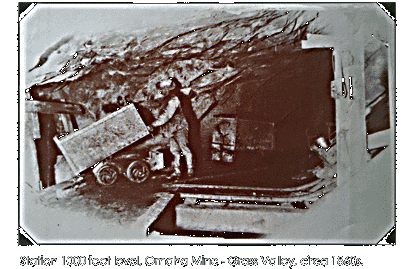
California Mining

THE CALIFORNIA GOLD RUSH
DEMANDED LAWS FOR PROSPECTORS
For 20 years after the gold rush of 1850, Congress and the courts were literally filled with controversial cases brought by so many prospectors on government land that the federal government enacted a new set of rules, called The General Mining Law of May 10, 1872; Federal Mining Statue 91 which after being amended many times, still exists in similar form today. After paying location and annual assessment fees, prospectors can hold unpatented federal land for the purposes of metal extraction. Under the Federal Land Policy and Management Act of October 21, 1976; 90 Statue 2743 affects locatable minerals, such as gold and silver, requiring recordation of mining claims with the Federal Bureau of Land Management (BLM) and authorizing regulations for environmental surface protection of public lands.
HISTORY OF MINING IN THE MOJAVE DESERT
After the gold rush was underway for almost 30 years in northern California, prospectors began wandering further south and locating gold and silver lode claims in the southern Mojave Desert. Early prospectors realized that similar geology to that found in the north, existed in southern California, after all, the Batholithic intrusion of granite and subsequent volcanic activity was seen throughout the state with quartz veins containing metals trending southeast from the Mother Lode. Some early miners were finding pockets of placer gold in southern California creek beds below the Sierra Mountain Range and with mule-pack grubstake, gold pans and little else, they ventured up into the mountains, locating many new small lode mining claims for gold and silver. What then developed as an entrepreneurial enterprise in the central Mojave Desert, near the town of Mojave, was a small ore crusher and milling site built near Mojave, California to process their ore. This seemingly unimportant mill site, the Burton Mill, reported to the California Division of Mines and Geology over the years that their insignificant mill had gold and silver sales of an astounding $25 million generated from ore processed from small mines during the late 1800s until closed in 1941 by presidential decree when we entered WW II. It is difficult to imagine now with gold over $1,700 per ounce, but in those years gold was selling for prices varying from $12 to $35, with an average of about $20 per ounce; and, in present-day dollars that small mill generated 85 times that amount or over $2 billion.
SIDEWINDER
In the Silver Mountains, along the same geologic trend, was a mine called Sidewinder that later became famous for producing over $2 million in gold and silver until closing in 1941. This mine is important as a cousin to the other Mojave Desert mines, with some reported records of over two-ounces per ton of mill run ore. In addition, during the operating years, metals were extracted from underground, downward in the subsurface in this mine to a shallow depth of only about 750 vertical feet. To the best of our present knowledge, none of the local mines in this southern Mojave Desert trend have been developed below this depth within the vein structure.
Copyright © 2001-present, Mojave Gold Mining & Exploration, Inc. ~ All Rights Reserved.